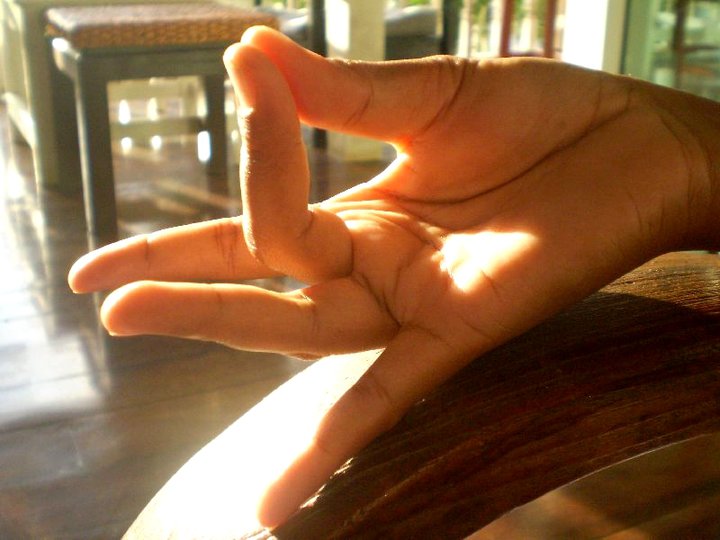

In Ayurveda when elements in our body are disturbs they compromise our physical, mind balance and therefore our immune system. If we don’t take action, to boost our immune system, our homeostasis is compromised and with time if our unbalances are not treated can lead to diseases.
Mudras are hand gestures used through yoga practices as well as in yoga, pranayama, meditation or mantra recitation.
In the Vedic sciences, especially in Ayurveda and Yoga, each finger of our hands is associated with an element: space or ether, air, earth, fire, water. In a special hand gesture called Mudra
- Your thumb represents the fire element
- The index finger represents the air element
- Your middle finger represents the element ether
- The ring finger represents the earth element
- The little finger represents the water element
It exists hundreds of mudras, some are done for health (to boost or sustain our immune system), others for wellbeing, some for creating certain other kinds of body processes and healing.
So for different aspects of life there are different mudras.
Why performing mudras?
They aim to bring back the elemental balance by guiding the flow of life energy within the body.
Depending upon the elements to be balanced, specific yoga mudras are practiced by manipulating the fingers. For example, to increase the water element in the body, varun mudra is practiced. Similarly, to reduce the air element in the body, Vayu mudra is practiced.
Science behind the mudras
The fingers of our hands are just like live wires of electric current. When the fingers touch others, it completes an electric circuit and the life energy flows through that circuit to balance the elements represented by those particular fingers.
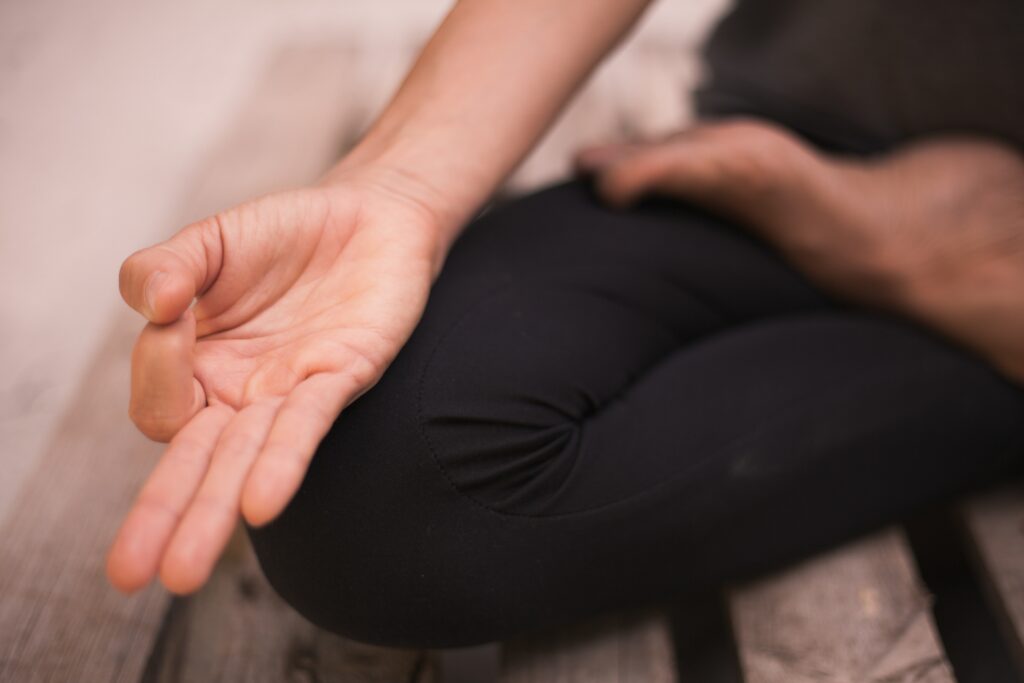

Importance of mudra
Mudras act as catalysts and switches in the body to improve body functions like immune system.
Concentration of mind is accomplished by mudras and regain lost energy.
Mudras tell us the state of mind such as physical, mental and spiritual. Deadly diseases like cancer, dementia, insomnia, diabetes, depression and minor diseases of cough and cold, vomiting, deficiency of vitamins and minerals can be cured or ease permanently.
Mudras help to link the brain to the body, soothe pain, stimulate endorphins, change the mood and increase our vitality. It also stimulates the brain, works on the nervous system, helps in relieving stress, improves concentration and lastly, it gives you a peaceful mind.
Classification of Mudra.
They can be classified into the five basic categories
Yogic:
According to Gheranda Samhita there are 25 mudras which give yogic accomplishments.
Spiritual:
Beneficial for concentration, knowledge, peace, generating love for humanity and so on.
These are gyan mudra, Dhyana mudra and Braham Anjali mudra.
Curative:
The mudras which are practiced boost immune system, curing diseases, to ward off the foreign elements from the body, to keep balance of elements in the body fall under this category. These are prana mudra, Apana mudra, Vayu mudra etc.
For religious purposes: the mudras which are practiced during performance of sacred and religious offerings are religious mudras. These are gyati mudras.
Customary:
When practiced these are beneficial for self and others. These are namaskar mudra, pranayama mudra.
Thus, the above mention mudras applied tension to the nerves or the neural which form the psycho neural circuits and it helps in balancing the five basic elements and reduce cough, cold, and bronchial infections. It also balancing the tension, and redirection of the internal energy effects the changes in veins, tendons, glands and sensory organs, to bring the body back to a healthy state.
Focus on Shiva linga mudra for your pratice:
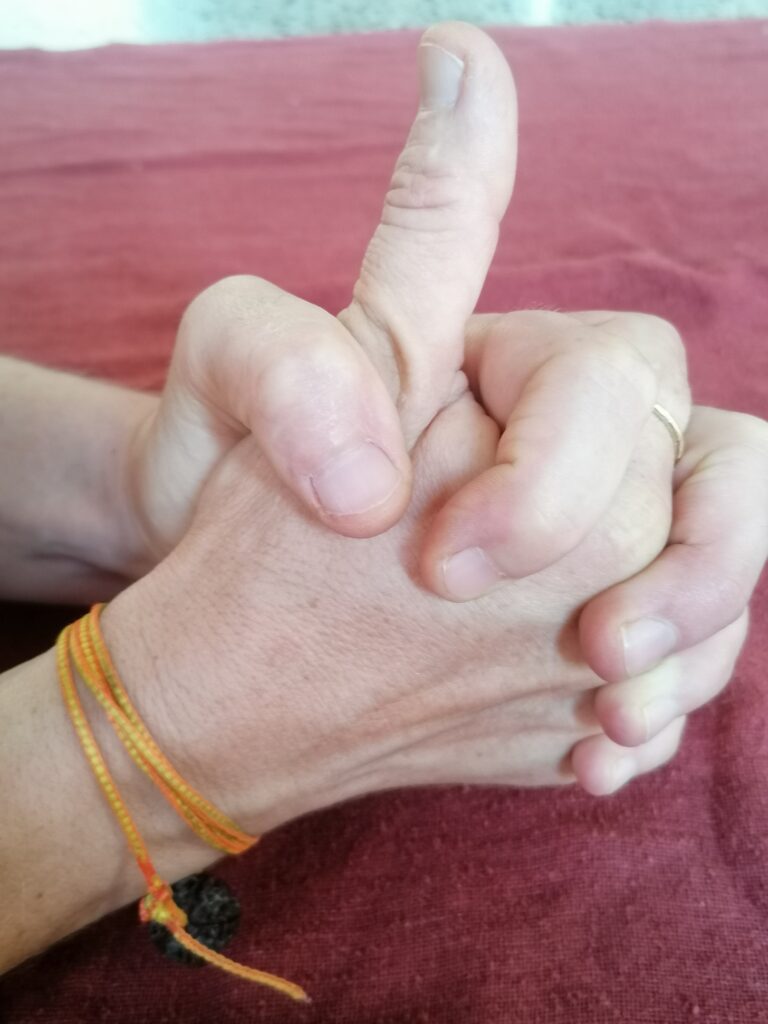

Linga Mudra: interlocking the fingers of both hands together (knuckle pointing outward), then straightening the thumb.
This mudra is known to generate heat and improve the breathing capacity of the body. The vertical position of the thumb in this mudra is considered a symbol of the Hindu god Shiva
Meaning Of Shiva linga mudra


Shiva Linga is the symbol of Shiva. The shape of the hands and the right thumb in linga mudra resembles that of the erect penis (phallus). In Sanskrit, the phallus is called Linga, hence the name of this mudra.
Fingers intertwined in linga mudra form the firm oval-shaped base that holds the shapeless structure upright. The intertwined fingers at the bottom represent the supreme power which contains the whole universe and the right thumb shows the creation.
In Hinduism, we therefore find the Shiva Lingam which is the most common among all the symbols of the god. The reason to worship Shiva Lingam comes from the fact that he symbolizes masculinity and has the power of creation. The lingam also rests on an oval shape which represents Yoni, the feminine power, because without it creation cannot take place
Benefits of Linga Mudra
The main benefit of Linga mudra is its ability to generate heat in your body. This generation of heat can help your body fight many infections, colds, mucus production, general lung disorders, bronchial colds and fever regulation.
Central heat helps you improve your metabolism and your respiratory functions. And regulating fever benefits your immunity and ability to fight infections. Linga mudra also has a few other benefits:
- Effective in weight loss
- Proven to be beneficial in increasing oxygen levels
- Relieves colds and flu
- Fights bacterial and viral infections
- Reduces mucus production and mobilized accumulated mucus Fights
- Infections and bronchial disorders
- Improves digestion
- Eliminates lethargy and laziness
- Increases self-confidence and willpower
- Boost immune system
- Improve potency and sexual health
- Can relieve menstruation in women
How to do Linga Mudra?
To begin, come into any comfortable position. Next, bring your hands in front of the chest.
Interlock the fingers of both hands so that the joint points outward. Point your right thumb up and take your left index finger and your left thumb around your right thumb. Join the fingertips of your left index finger and left thumb behind your right thumb.
You can also practice the linga mudra by raising your left thumb and encircling it with your right index finger and right thumb. You can rest your hand on your lap next to your solar plexus.
Ideally, this mudra should be practiced for 45 minutes a day. From cover to cover or in three parts of 15 minutes each. However, you can start by training in three parts, with 5 minutes in each part.
Body postures for performing the linga mudra
The linga mudra can be performed in different sitting and standing positions. You can sit in a chair with an erect spine and try this mudra. This is the most relaxed way to practice. However, in yoga style, perform a seated mudra in sukhasana, padmasana, or any other seated cross-legged pose. Cross-legged seated poses will improve your immunity, metabolism, and concentration. You can also sit in a Vajrasana which will improve digestion benefits.
However, if one wants, one can also do linga mudra while standing or walking. While doing this, stand straight with your legs hip-width apart. Keeping your spine straight, maintain your spine length, press your shoulders and push your head back in line with your hip.
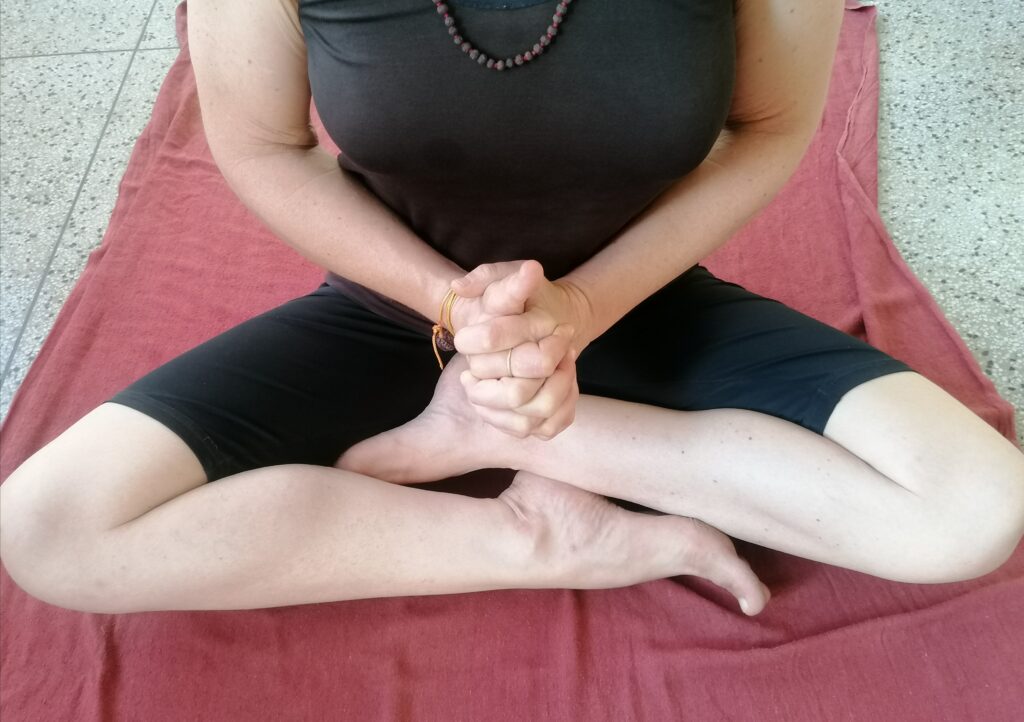

Effect on 3 Doshas
I remind you that the five fingers of your hands represent five elements (and therefore different groups of energies, Vata, pitta, Kapha,) fire, air, space, earth and water.
Linga Mudra‘s interlocking finger technique allows the air, space and earth elements to merge and overlap and allows the air and fire elements to stand out. This mudra will increase the interaction between the air and fire elements; air always helps the fire to spread. Fire represents the warmth and vitality of your body. This mudra uses the air element to stimulate the fire element and spread the force of vitality and vigor throughout your body and mind.
The Linga Mudra balances Pitta (air and fire) and Kapha (water and earth) in your body. Pitta stimulating nature (boosting digestion and metabolism) of the linga mudra will ensure, Kapha energies that are out of balance Excessive Kapha energies can cause problems such as depression, lethargy, asthma and weight gain.
A body and mind well balanced maintain our immune system. If you feel any disorders it is time to boost your immunity.
How long to practice?
Too much linga mudra can raise your body temperature beyond safe limits. Too much can upset the Pitta-Kapha balance and make you feel sluggish or feverish. Also, it can show side effects such as high blood pressure, profuse sweating, nausea, and dehydration.
Indeed, these sensations can be considered as parameters determining the duration. Once you start feeling these sensations, you definitely need to reduce your overall duration.
Each person has a different constitution, so if you start to feel hot sensations even before 45 minutes of practice, you will need to shorten your duration further. To start, do not try 45 minutes in a row, but in three parts of 15 minutes each.
When to practice?
Linga mudra can be practiced at any time, it’s just that you will need to make sure that before practicing your body temperature is normal and heart and respiratory vital signs are normal.
You can practice the linga mudra in the morning and in the evening. Morning and evening practice sessions will increase the benefits of the mudra on immunity and temperature regulation.
Since this mudra helps with digestion, it might be an instinct to practice directly after meals, but that would be a bad idea. The digestive benefit is more of an indirect benefit. However, is to raise your body temperature, which can be counterproductive on a full stomach.
The linga mudra also goes very well with meditation. Calm your mind and focus on clearing your negative thoughts. If necessary, use means such as single-pointed concentration, musical concentration, or even mantras. You can even sing simple affirmative slogans like, “I offer all negative qualities in the fire of transformation.”
Precautions and contradictions
To boost immune system is one thing but some precautions relating to the linga mudra have to be taken. Since mudra is a powerful body heat booster, you should not consume an excess of body warming foods like red meat, animal fat, processed foods and full fat dairy products before its practice.
Also, avoid activities that raise body temperature throughout your day, and especially after practicing the Linga Mudra. If you practice other training routines, you will also need to be careful about the selection and duration of your exercises.
You should avoid practicing linga mudra if you have conditions such as menopause, thyroid disorder, ulcer, hypertension, migraine or recent stroke.
Conclusion
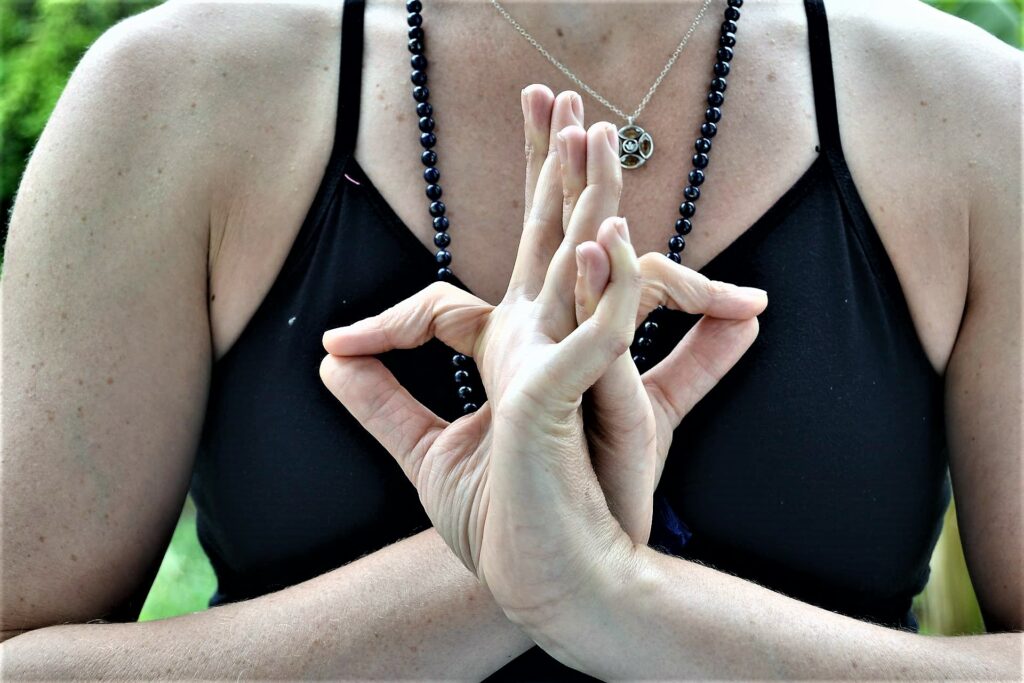

So, the various types of yoga mudra may be practiced anytime, anyplace, in the bus, train, car, office or at home. It is suggested by experts that the yoga mudras should be practiced for minimum 24 minutes incessantly for good results. It can also be done for five minutes at a time as well.
To believe it, you must try it. There is nothing to lose and much to gain.
Why not to try instead of taking chemicals…I know to perform Mudra it is asking a minimum of effort and patience… The most important thing is it is natural and your work with your inner healing power. And that’s true that we don’t learn that at school 🙂
Enjoy your practice, do it with awareness, peace and meaning 🙂
And tele me in comment what you felt after yourpractice…
Hari Om
Take care
References
https://www.ncbi.nlm.nih.gov/pmc/articles/PMC5934951/
https://pubmed.ncbi.nlm.nih.gov/398852/
https://pubmed.ncbi.nlm.nih.gov/29755225/
https://pubmed.ncbi.nlm.nih.gov/28285240/
https://escipub.com/gjr-2019-02-1605/
Books:
kriya Yoga Sutras of Patanjali and Siddhas Govindham Pages 185 – 209.
Yoga for daily life B Y K K Suman Pages 261-270- chakras
